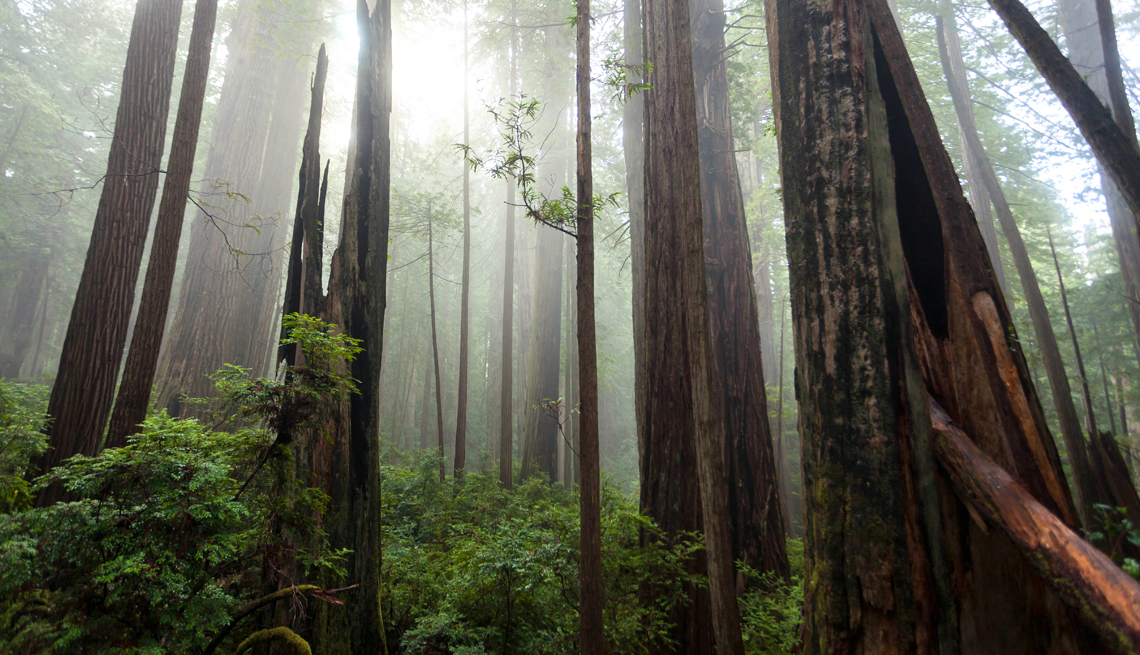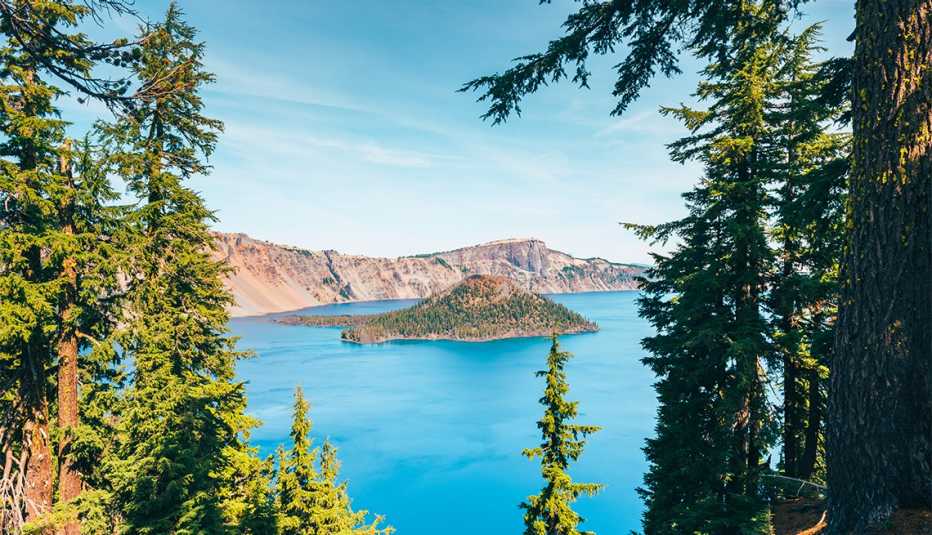AARP Hearing Center
Mist steals through towering trees soaring up to 380 feet as thrushes sing melancholy notes from the canopy. On the ground, fallen trees expose upturned root beds more than 6 feet in diameter.
It’s another early morning in Redwood National and State Parks (RNSP) in Northern California. These mammoth woods are home to the tallest trees on Earth in a coastal preserve of old-growth redwood forests, a UNESCO World Heritage Site and International Biosphere Reserve as well as a national park. Just 5 percent of the more than 2 million acres of redwoods originally found in Northern California remain, and RNSP protects nearly half of those.
Indigenous people used only fallen redwoods to build canoes and homes. But after gold was discovered in northwest California in 1849, commercial logging indiscriminately felled the tall trees, inspiring the formation of the conservationist group Save the Redwoods League in 1918. Three state parks — from north to south, Jedediah Smith Redwoods, Del Norte Coast Redwoods and Prairie Creek Redwoods — followed in the 1920s. It wasn’t until 1968 that Congress dedicated the land around them as Redwood National Park to pull all of them together to protect the greater watershed. The National Park Service and the California Department of Parks and Recreation jointly manage the parks’ roughly 132,000 acres, home to prairies, two major rivers and 37 miles of Pacific coastline in addition to redwood forests (the state parks are distinct on maps, but national park land surrounds and joins them in a continuous whole).
RNSP is about 325 miles north of San Francisco and 320 miles south of Portland, Oregon. Perhaps because there are easier-to-reach redwood groves, including Muir Woods National Monument near San Francisco, the park gets less than a half-million visitors annually. But if you’re a nature lover and make the effort to reach it, you’ll find solace in the big forests (including via six ADA-accessible trails), scenic drives along the coast and among the trees, and a uniquely vegetated canyon. Plus, you may spot brown bears and Roosevelt elk inland, and flocks of seabirds and migrating gray whales offshore.


Location: North Coast, California
Acreage: 131,983 acres
Highest elevation: 3,000 feet
Miles of trails and how many: More than 200 miles over 55 trails
Main attraction: Massive redwood trees close to 400 feet tall
Cost: Redwood National and State Parks are free. Day-use areas at Gold Bluffs Beach/Fern Canyon cost $12 per vehicle; at Jedediah Smith Campground, $8.
Best way to see it: Hiking the woods and craning your neck to see the canopy
When to go to avoid the crowds: Spring and fall
Plan Your Trip
In northernmost California, RNSP runs about 50 miles north to south, beginning just below the California-Oregon border. Getting there requires at least a five-hour drive from either San Francisco or Portland, taking Interstate 5 most of the way (California drivers have the more scenic option of taking U.S. Highway 101 north from San Francisco through Marin, Sonoma and Mendocino counties to the parks). Driving curvy State Route 299 west from Redding, California, 132 miles east of the parks, takes about 3½ hours.
Well-signed and well-maintained 101 is the main artery through the parks between coastal Crescent City in the north and Eureka, the closest city to them in the south, making for easy transit through the preserves. Entry is largely free, except for a few day-use areas where daily parking fees range from $8 to $12.
There are many entrances to the parks, which have five visitor centers that provide updates on trail conditions, maintain exhibits on the park ecosystem and more. In the south, stop at the Thomas H. Kuchel Visitor Center on a beach to check for passing gray whales (peak migration months are November to December and March to April). Like the other centers, it runs a bookshop stocked with titles on nature. The Prairie Creek Visitors Center in the Prairie Creek park is housed in a 1930s cabin built by the Civilian Conservation Corps. Rangers at all but the Crescent City center at the park headquarters lead walks and talks in summer.
Redwood trees thrive in the cool coastal conditions of Northern California. Expect temperature highs in the upper 60s in summer and frequent rain in winter (60 to 80 inches, on average, from October through April), when temperatures range from the 40s to the low 60s. Wet winters and strong winds can topple trees and close trails, so always check the RNSP website for current conditions. Clear weather and school vacation schedules meet in summer’s high season, attracting more visitors, but spring and fall are good times to catch fair conditions with fewer crowds. Come from mid-spring to early summer to see the native rhododendrons in bloom.
Cellular coverage is very limited, with the best service around Crescent City and at the visitor centers. Restrooms can be found at most trailheads, campgrounds and visitor centers.


Where to stay and dine
Your options are few if you want to spend the night in the parks, where there are only four campgrounds (no hotels). The Jedediah Smith State Park Redwoods Campground in the eponymous park has 86 sites in a redwood forest on the Smith River, and Elk Prairie Campground in the Prairie Creek Redwoods State Park has 75 sites in a mixed forest. Each one also has four basic ADA-accessible cabins, which you won’t find in the other two camps. Gold Bluffs Beach Campground, also in Prairie Creek, has 26 sites beside a beach, and Mill Creek Campground in the Del Norte Coast Redwoods State Park has 145 sites in a forest of maples, alders and young redwoods. Amenities in the four include ADA-accessible restrooms with hot showers, picnic tables, firepits and dump stations. RVs are allowed, but there are no hookups. The cabins come with electricity, heaters and outdoor fire rings but no kitchens or restrooms (guests do have access to the campground’s facilities a short distance from the cabins). Whatever your choice, reserve in advance at Reserve California (campsites, $35 per night; cabins, $80 winter, $100 in summer).
There are many home rentals, inns and hotels in nearby communities (See Gateway towns, below).


































































